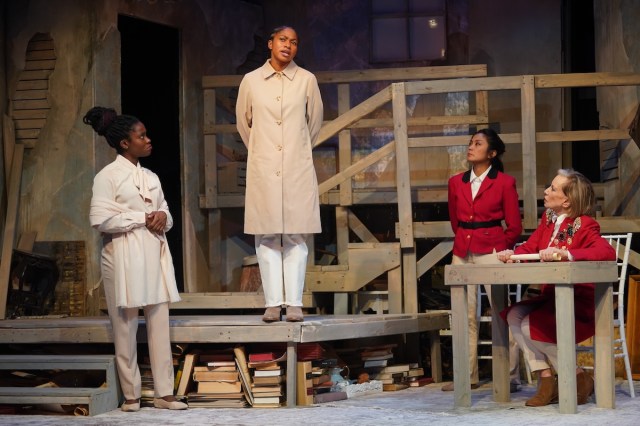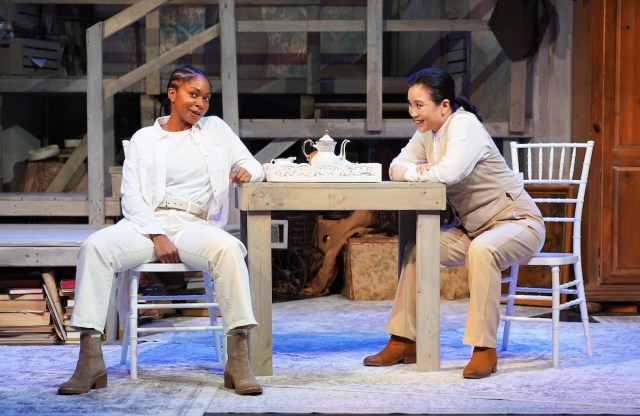Review: The Devil’s Disciple, Shaw’s Comedy of Cuckoldry in the American Revolution
Gingold Theatrical Group returns to Theatre Row with a liberally revised revival.

(© Carol Rosegg)
A century before Aaron Sorkin climbed on his soapbox, Bernard Shaw was assaulting audiences with his progressive opinions and speaking truth to power in magnificent prose. Regular theatergoers will know his plays Major Barbara, Saint Joan, and Pygmalion. But they might not be as familiar with his 1897 hit The Devil’s Disciple, now somewhat obscure despite multiple screen adaptations and Broadway revivals (the last in 1988).
Luckily, Gingold Theatrical Group and its stalwart leader David Staller (who directed and adapted this radically reimagined production) are keeping the flame alive for Shaw off-Broadway. The Devil’s Disciple is a particularly appropriate play for this election as we contemplate where we’ve been as a nation and where we’re going.
Set in New Hampshire circa 1777, the story concerns Richard Dudgeon (Nadia Brown), who has recently come into a handsome inheritance over the objections of his sour mother (Susan Cella). Dick is known locally as “the Devil’s Disciple” for his habit of questioning Yankee Puritan conventional wisdom, and most people shun him.

(© Carol Rosegg)
Despite Dick’s heresy, Reverend Anthony Anderson (Tina Chilip) feels it is his Christian duty to warn him that the British Army is looking for rebels to hang, and he knows no one more rebellious than Dudgeon. Dick suspects that the redcoats would rather set an example by executing an upstanding pillar of the community.
Naturally, he’s correct, but when the Brits come to apprehend their man, they confuse Dudgeon for Anderson, a mistake he is happy to allow them to make. The rascal reinforces the switcheroo by stealing a kiss from the rev’s wife, Judith (Folami Williams), knocking her off her feet and convincing the credulous British that he is indeed their man.
A wit who cares not a whit for the manners of the day (but quietly embodies timeless virtue), Dudgeon is the archetypal Shavian hero, brought stunningly to life by Brown. She doesn’t offer the ultra-dry, unmistakably Victorian line readings one might assume from the text. Instead, Brown’s Dick is a grinning, irresistibly charming flirt. He can see the everyday theater transpiring around him and finds it utterly hilarious, a source of laughter and other pleasures.
It helps that Brown has palpable chemistry with Williams, their love-hate push-pull percolating from the moment of Judith’s earliest assessment of Dick — “You should be burnt alive” — a GBS pickup line if there ever was one. It transforms this 127-year-old play into the most charming rom-com currently performing in New York.

(© Carol Rosegg)
If you’re getting lesbian Masterpiece Theater vibes, that’s part of the fun, and it’s Staller’s most brazen invention. The director has built a new frame for this old picture, casting Brown in the added role of a narrator who has recently inherited a 248-year-old house, in which she has discovered Judith Anderson’s diary. It’s a steamy read, enjoyed by generations of female residents who now haunt the attic, where this staging transpires. They all come together to enact this smartly compressed five-woman version of Shaw’s play.
Staller’s metatheatrical adaptation benefits from the bold choices and perfect comic timing of Teresa Avia Lim, who plays Christy Dudgeon, Dick’s ward Essie, and a whole army of redcoats. Chilip’s Major Swindon, Shaw’s send-up of small-minded English bureaucrats, is a little fuzzier, a performance that doesn’t quite pop like it should. Occasionally, the stars align and Cella delivers a pitch-perfect General Burgoyne, a mouthpiece for top-shelf Shavian witticisms (“I should never dream of hanging any gentleman by an American clock”). We lean forward in anticipation of the most memorable performance of the play. And it would be if she could get solid on her lines.

(© Carol Rosegg)
Despite individual flaws, the ensemble gels, and the world Staller has created coheres, aided by Lindsay Genevieve Fuori’s crumbling attic wonderland of a set and the deep-storage wardrobe of costume designer Tracy Christensen. I howled at the glittering costume brooches she selected to represent medals in the British army. Julian Evans provides the killer sound cue that undergirds Staller’s framing convention, collaborating nicely with lighting designer Jamie Roderick on several thunderstorms, which illuminate the space between the wooden slats of the upstage wall. We get the sense the whole thing could collapse at any moment.
It looks like a candidate for the wrecking ball, but maybe this rickety metaphor for the American republic is worth salvaging. Brown is pointed and impassioned when she delivers Richard’s gallows speech about America as “a land that will never be home to kings or tyrants or demagogues.” It sounds more like Sorkin than Shaw, but it’s pure Staller — a modern update as part of gut renovation of an old play, the bones of which are still good. Maybe that’s the treatment this old house needs.









